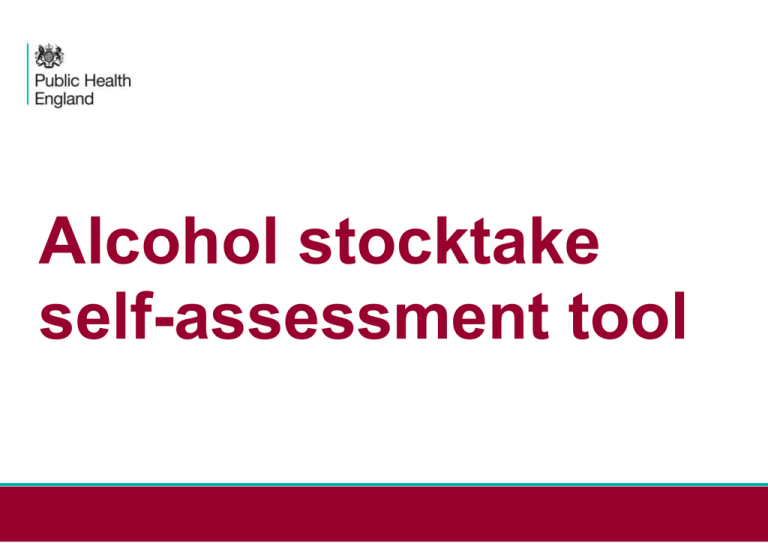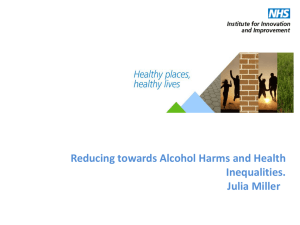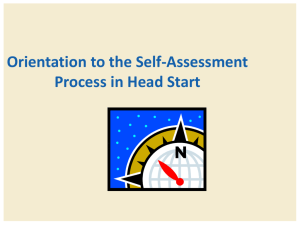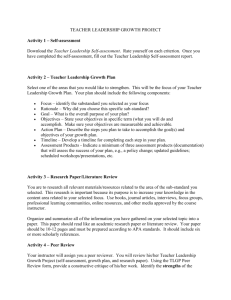Alcohol stocktake self-assessment tool (docx
advertisement

Alcohol stocktake self-assessment tool Alcohol stocktake self-assessment tool About Public Health England Public Health England’s mission is to protect and improve the nation’s health and to address inequalities through working with national and local government, the NHS, industry and the voluntary and community sector. PHE is an executive agency of the Department of Health. We were established on 1 April 2013 to bring together public health specialists from more than 70 organisations into a single public health service. Public Health England Wellington House 133-155 Waterloo Road London SE1 8UG Tel: 020 7654 8000 http://www.gov.uk/phe @PHE_uk PHE August 2013 For queries relating to this document, please contact: 020 7972 1945 2 Alcohol stocktake self-assessment tool About this tool This stocktake tool is designed to provide a structure for local areas to take a systematic view of their system for responding to alcohol-related harm in the adult population. Aim To raise standards of planning and delivery of integrated alcohol prevention and treatment systems. Purpose This stocktake tool provides an opportunity to benchmark against evidence-based practice, thereby facilitating the identification of effective practice, highlighting any gaps and informing improvement activity. It is recommended that users identify the best evidence against each criterion. Criteria are hopefully clear and their meaning selfevident. However, where there may be room for query or misinterpretation some self-assessment guidance is provided, denoted by . The self-assessment criteria cover seven domains, grouped into five broad sections: Strategic leadership and planning Domain 1 Needs assessment and data Domain 2 Finance Domain 3 Pathways Who it is for • Directors of Public Health • Strategic Lead Officers • Commissioning Officers • Provider Managers Primary prevention Domain 4 Population level actions How to use the stocktake tool It is likely that a range of strategic, commissioning and provider stakeholders will need to be involved in order to identify evidence across all domains. It will probably be helpful to identify a lead for the self-assessment process, who will co-ordinate identification and ultimate assessment of the evidence. Hospital-based alcohol services Domain 6 Hospital-based alcohol services Secondary prevention Domain 5 Targeted interventions Tertiary prevention Domain 7 Specialist treatment 3 Alcohol stocktake self-assessment tool Version Partnership Domain criteria Date Comments / evidence identified Strategic leadership and planning 1. Needs assessment and data 1.1 The local JSNA includes a comprehensive section on alcohol-related harm that reflects need across the whole spectrum of harm and readily acknowledges the impact of alcohol work across the PHOF and NHSOF resulting in partnership collaboration and support. 1.2 Needs assessment, the local commissioning strategy, CCG strategy and Joint Health and Wellbeing Strategy (JHWS) demonstrate an explicit link between evidence of need and service planning. 1.3 There is an alcohol planning document that describes how best to meet local need, which clearly identifies: • the level of local demand • existing strengths and ways in which services can be commissioned • finance and resources made available. There is a shared understanding of local level of demand and need, based on a range of local and national data across a range of public services. Local data on alcohol interventions provided in hospitals, Primary Health Care, and other settings is collected to inform needs assessment. The commissioners have analysed the local levels of alcohol-related admissions to hospital in order to target interventions. The commissioners have analysed and monitored local specialist treatment data including specific breakdown by gender, age, postcode, condition, route of admission, repeat admission, etc. in order to compare current treatment provision with need. There are contracts in place for commissioned services that specify the outcomes to be achieved that are regularly monitored and reviewed. 1.4 1.5 1.6 1.7 1.8 4 Alcohol stocktake self-assessment tool Strategic leadership and planning 2. Finance 2.1 Investment is sufficient for a range of alcohol harm reduction services, including primary prevention, early intervention and specialist treatment, that is commensurate with the level of identified need. 2.2 The partnership can identify the total level of local investment in alcohol harm reduction by all partners who contribute to delivery. 2.3 A value for money approach is a fundamental part of the commissioning strategy and the effective management of budgets. 3. Pathways 3.1 The general public, service users and staff in other mainstream services have ready access to information that enables them to understand the alcohol services available, the pathways between them and points of entry. 3.2 Alcohol pathways for both alcohol dependent and hazardous/harmful drinkers are jointly agreed and regularly monitored and reviewed by all relevant local partners. 3.3 Care pathways and services are geographically and socioculturally appropriate to those for whom they are designed. 5 Alcohol stocktake self-assessment tool Secondary prevention Primary prevention 4. Population level actions 4.1 Where local alcohol social marketing campaigns are employed, they reflect, and amplify, national campaign messages when appropriate. 4.2 Local crime and health & social care data are used to map the extent of alcohol-related problems as part of licensing policy. 4.3 Hospital and ambulance data are shared routinely to inform improvements in community safety activity. 4.4 A 'cumulative impact' policy is adopted if an area is saturated with licensed premises informing the consideration and implementation of the range of measures and conditions available to the local licensing board. 4.5 Optimal use is made of existing legislation to target the prevention of under-age sales, sales to people who are intoxicated, proxy sales to minors, non-compliance with any other alcohol licence condition and illegal imports of alcohol. 4.6 Local arrangements are brokered with industry partners to promote responsible marketing, promotion and selling of alcohol. 4.7 The Responsibility Deal is appropriately promoted and facilitated, with a range of local organisations committing their support. 5. Targeted interventions 5.1 The JHWS clearly indicates that the partnership has an integrated plan that sets out the agreed roles and responsibilities of partners, including workforce development, to roll out Identification and Brief Advice (IBA) in a range of settings with a system in place to monitor activity. 5.2 Services that deliver IBA collect, analyse and report data to demonstrate the level of delivery. 5.3 Local ‘Making Every Contact Count’ (MECC) activity includes evidencebased alcohol IBA. 5.4 NHS Health Check programme includes evidence-based alcohol IBA in line with regulations and guidance. 5.5 There is IBA delivery across a range of adult local authority services, criminal justice and health settings. 6 Tertiary prevention Hospital-based alcohol services Alcohol stocktake self-assessment tool 6. Hospital-based alcohol services 6.1 A joint commissioning approach is adopted where there is a shared responsibility for commissioning and planning e.g. LA/CCGs around hospital-based services pathways. 6.2 Alcohol Care Teams are contracted and employed in all acute hospitals where they could have an impact. 6.3 Senior medical/nursing support and leadership is provided to the postholder(s) to ensure that their role and function is understood, and utilised by partners in the system. 6.4 Linkages to and in-reach from community alcohol services is offered to support patients requiring further treatment and recovery support e.g. housing. 6.5 There is a range of services to support and reduce the number of frequent hospital attenders. 7. Specialist treatment 7.1 There is an integrated alcohol prevention and treatment system configured to meet the needs of the local population across community and prison settings. 7.2 A joint commissioning approach is adopted where there is a shared responsibility for commissioning and planning e.g. LA/NHS England around prison/community services pathways. 7.3 There is sufficient capacity in the treatment system to address the needs of the local estimated dependent population. 7.4 Services are commissioned to target highest risk groups, wherever they are located within the community. 7.5 There is an explicit information governance agreement across all services to ensure that information is shared routinely to support effective care delivery and risk management. 7.6 Alcohol treatment providers report data to the National Drug (and alcohol) Treatment Monitoring System (NDTMS) and this data is analysed locally to inform improvements. 7 Alcohol stocktake self-assessment tool Tertiary prevention 7.7 Treatment Services in all settings offer evidence-based, effective recovery-orientated interventions in line with NICE guidance and Quality Standards including, where appropriate, Quality Statements 4, 5, 7, 8, 9, 10, 11, 13,) and, for example, service improvement tools such as clustering and packages of care tools. 7.8 A range of recovery support interventions and services are accessible to facilitate the recovery journey e.g. peer support, mutual aid, family/parenting support, employment, training and housing. 7.9 The outcomes from treatment interventions are measured, reported and analysed on a regular basis to demonstrate effectiveness and inform planning. 7.10 There are integrated pathways in place between the prison and community alcohol treatment and recovery support services to ensure a managed through-care that are monitored and improved on a regular basis. 7.11 Treatment providers have workforce plans that describe how specialist staff are trained and supported to ensure appropriate competence and supervision to deliver specialist interventions. NICE quality statement 4 8 Alcohol stocktake self-assessment tool Self-assessment guidance Return to section 1234567 Criteria 1.1 The JSNA describes primary, secondary and tertiary prevention measures agreed by a range of partners and stakeholders. 1.2 There is clear congruity between all documents from needs assessment to strategic planning. 1.5 This might include data from: NHS Health Check, DES, LES (or equivalent), hospital services. 1.6 Commissioners use analysis of alcohol-related admissions to identify in-need population groups so that appropriate, accessible services can be designed and located. 1.8 Contracts should cover all commissioned services from primary prevention to structured treatment. 2.2 Investment in services across the whole spectrum of alcohol interventions including any from e.g. NHS, Police, private sector. 3.3 Service location and culture are such that the most in-need groups can access them and choose to use them. 4.1 Local areas may decide that they are adequately served by national campaigns, but where local health campaigns about, or including alcohol are employed they are in line with the national messages e.g. Change for Life. 4.3 Evidence of use of anonymous A&E and ambulance data to improve community safety responses and, where appropriate, to inform licensing decisions. 4.6 This refers to voluntary agreements with industry partners. Draft responsibility deal toolkit 5.2 Reporting in this case refers to reporting to local commissioners in order that delivery can be monitored and driven. 5.3 Evidence-based IBA is described in NICE guidance PH24. 5.4 Evidence-based IBA is described in NICE guidance PH24. Health Check regulations require an alcohol screen and Health Check guidance recommends that brief advice is given to those who are indicated as increasing or higher risk. 5.5 IBA can potentially be delivered by anyone in a helping position. Appropriate settings would include GP practices, Urgent care, walkin centres, A&E, community pharmacy, probation services, courts, prison, police custody, local authority mental health, disability and elderly services, fire & rescue, housing and leisure services. 6.2 "Alcohol Care Team" is a generic term for services or groups of services in hospitals, which may be individually referred to Alcohol Liaison Nurse, Alcohol Specialist Nurse, Alcohol Health Worker services, etc. The NICE Clinical Guidance Alcohol dependence and harmful alcohol use (CG115) and Alcohol-use disorders: physical 7.7 complications (CG100) are relevant to structured alcohol treatment. Return to section 1234567 9 Alcohol stocktake self-assessment tool Further links to related guidance and resources Social Marketing http://www.alcohollearningcentre.org.uk/Topics/Browse/SocialM arketing/ Brief Advice Leaflets http://www.nhs.uk/Change4Life/Pages/drink-less-alcohol.aspx http://www.alcohollearningcentre.org.uk/_library/Change4Life/4 08723_Your_Drinking_And_You.pdf Awareness Raising / Self-help http://www.nhs.uk/change4life/pages/sneaky-drinks.aspx http://www.alcohollearningcentre.org.uk/Topics/Browse/BriefAd vice/?parent=4444&child=5007 Licensing and responsible sales http://www.alcoholpolicy.net/licensing/ E-learning Courses http://www.alcohollearningcentre.org.uk/eLearning/IBA/ http://www.alcoholpolicy.net/2013/04/licensing-informationpack-toolkit-supports-data-collection-and-decision-making.html Training Resources http://www.alcohollearningcentre.org.uk/eLearning/Training/ https://www.gov.uk/government/publications/police-reform-andsocial-responsibility-act-supporting-guidance DES Guidance http://www.nhsemployers.org/Aboutus/Publications/Documents/ 2013-14-GMS-contract-Guidance-audit-requirements.pdf Data Sharing http://www.alcohollearningcentre.org.uk/Topics/tags/?tag=data %20sharing NHS Evidence https://www.evidence.nhs.uk/search?q=ALCOHOL+CARE+TEA M http://www.alcohollearningcentre.org.uk/eLearning/violence_elearning/ Care Team Examples http://www.alcohollearningcentre.org.uk/LocalInitiatives/project s/projectDetail/?cid=6371 Alcohol Screening Tools http://www.alcohollearningcentre.org.uk/Topics/Browse/BriefAd vice/ Related NICE Guidance PH24 http://www.nice.org.uk/PH24 CG115 http://www.nice.org.uk/CG115 CG100 http://www.nice.org.uk/CG100 10





